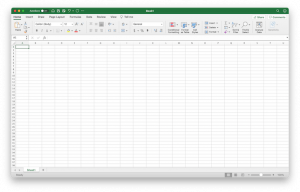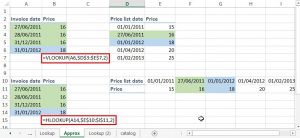First In First Out (FIFO) and Last In First Out (LIFO) calculations are the integral part of an Accounting System. Neither calculation will affect the life to date (LTD) allocation. However, the choice of either FIFO or LIFO will affect the periodic recognization of profit or loss. It all comes down to the timing difference of profit recognition but its impact can be huge for company’s bottom line.
Most sophicated accounting software will do the calculation of such allocations once the accounting methodology (FIFO or LIFO) is chosen. However, for small business owners without high-end accounting software or system, the attached Excel file can be handy. In addition, such allocation, especially the FIFO calculation, can also be used for many other purposes. For example, I once created an MS Access file with similar Visual Basic (VB) modules to do such calculation for profit recognition of many individual portfolio which consists of many debt securities with numerous transactions. It is a critical part of tax calculations. I used the same logic and created VB modules in the downloadable MS Excel file.
There are two main VB modules in the Excel file. The first module (SortData) is to copy and paste the transactions into a temporary worksheet and sort them either by FIFO or LIFO methodology according to the user’s choice.
Sub SortData()
Dim PurchaseLastCell As Integer, SalesLastCell As Integer
Dim AllocChoice As Integer
Sheets(“Summary”).Select
Range(“SummaryFirstCell:E2000”).Select
Selection.ClearContents
Range(“SummaryFirstCell”).Select
If Range(“AllocType”).Value = “FIFO Allocation” Then
AllocChoice = 1 ‘FIFO
Else
AllocChoice = 2 ‘LIFO
End If
Sheets(“Sort”).Select
Columns(“A:L”).Select
Selection.ClearContents
Sheets(“Purchase”).Select ‘Copy Purchase Data to “Sort” worksheet for later sorting
Columns(“A:D”).Select
Selection.Copy
Sheets(“Sort”).Select
Range(“A1”).Select
ActiveSheet.Paste
Sheets(“Sales”).Select ‘Copy Sales Data to “Sort” worksheet for later sorting
Columns(“A:D”).Select
Application.CutCopyMode = False
Selection.Copy
Sheets(“Sort”).Select
Range(“G1”).Select
ActiveSheet.Paste
Range(“A1048576”).End(xlUp).Select
PurchaseLastCell = ActiveCell.Row
Range(“G1048576”).End(xlUp).Select
SalesLastCell = ActiveCell.Row
‘Sort Purchase Data by 1. Inventory, 2. Purchase Date, and 3. Purchase Unit. The reason why sorted by the Purchase Unit is because there may be multiple
‘purchase in the same day. Since there is no time input for the Purchase Date, so arbitrarily sorted by the Purchase Unit.
Columns(“A:D”).Select
Application.CutCopyMode = False
ActiveWorkbook.Worksheets(“Sort”).Sort.SortFields.Clear
ActiveWorkbook.Worksheets(“Sort”).Sort.SortFields.Add Key:=Range(“A2:A” & PurchaseLastCell), _
SortOn:=xlSortOnValues, Order:=xlAscending, DataOption:=xlSortNormal
ActiveWorkbook.Worksheets(“Sort”).Sort.SortFields.Add Key:=Range(“B2:B” & PurchaseLastCell), _
SortOn:=xlSortOnValues, Order:=xlAscending, DataOption:=xlSortNormal
ActiveWorkbook.Worksheets(“Sort”).Sort.SortFields.Add Key:=Range(“C2:C” & PurchaseLastCell), _
SortOn:=xlSortOnValues, Order:=xlAscending, DataOption:=xlSortNormal
With ActiveWorkbook.Worksheets(“Sort”).Sort
.SetRange Range(“A1:D” & PurchaseLastCell)
.Header = xlYes
.MatchCase = False
.Orientation = xlTopToBottom
.SortMethod = xlPinYin
.Apply
End With
‘Sort Purchase Data by 1. Inventory, 2. Sales Date, and 3. Sold Unit. The reason why sorted by the Sold Unit is because there may be multiple
‘sales in the same day. Since there is no time input for the Sales Date, so arbitrarily sorted by the Sold Unit.
Columns(“G:J”).Select
ActiveWorkbook.Worksheets(“Sort”).Sort.SortFields.Clear
ActiveWorkbook.Worksheets(“Sort”).Sort.SortFields.Add Key:=Range(“G2:G” & SalesLastCell), _
SortOn:=xlSortOnValues, Order:=xlAscending, DataOption:=xlSortNormal
If AllocChoice = 1 Then ‘FIFO
ActiveWorkbook.Worksheets(“Sort”).Sort.SortFields.Add Key:=Range(“H2:H” & SalesLastCell), _
SortOn:=xlSortOnValues, Order:=xlAscending, DataOption:=xlSortNormal
Else ‘LIFO
ActiveWorkbook.Worksheets(“Sort”).Sort.SortFields.Add Key:=Range(“H2:H” & SalesLastCell), _
SortOn:=xlSortOnValues, Order:=xlDescending, DataOption:=xlSortNormal
End If
ActiveWorkbook.Worksheets(“Sort”).Sort.SortFields.Add Key:=Range(“I2:I” & SalesLastCell), _
SortOn:=xlSortOnValues, Order:=xlAscending, DataOption:=xlSortNormal
With ActiveWorkbook.Worksheets(“Sort”).Sort
.SetRange Range(“G1:J” & SalesLastCell)
.Header = xlYes
.MatchCase = False
.Orientation = xlTopToBottom
.SortMethod = xlPinYin
.Apply
End With
Range(“A1”).Select
End Sub
Sub Allocation()
Dim PurchaseLastCell As Integer, SalesLastCell As Integer
Dim p As Integer, s As Integer, cnt As Integer
Dim Prev_p As Integer, Prev_s As Integer
Dim Prev_PItem As Variant, Prev_SItem As Variant
Dim PRecord As Integer, SRecord As Integer
Dim PInventory As Variant, PDate As Variant, PUnit As Variant, PCost As Variant ‘Purchase Array
Dim SInventory As Variant, SDate As Variant, SUnit As Variant, SPrice As Variant ‘Sales Array
Dim Remain_PUnit As Integer, Remain_SUnit As Integer
Dim Unit_Alloc As Integer
Dim Profit As Currency, Summary_Profit As Currency
Dim Summary_PUnit As Long, Summary_SUnit As Long
Dim ErrorMsg As Integer
ActiveWorkbook.Worksheets(“Allocation”).Select ‘Clear the history
Range(“A2:K30000”).Select
Selection.ClearContents
ActiveWorkbook.Worksheets(“Sort”).Select
Range(“A1048576”).End(xlUp).Select
PurchaseLastCell = ActiveCell.Row
Range(“G1048576”).End(xlUp).Select
SalesLastCell = ActiveCell.Row
PInventory = Range(“A2:A” & PurchaseLastCell).Value
PDate = Range(“B2:B” & PurchaseLastCell).Value
PUnit = Range(“C2:C” & PurchaseLastCell).Value
PCost = Range(“D2:D” & PurchaseLastCell).Value
SInventory = Range(“G2:G” & SalesLastCell).Value
SDate = Range(“H2:H” & SalesLastCell).Value
SUnit = Range(“I2:I” & SalesLastCell).Value
SPrice = Range(“J2:J” & SalesLastCell).Value
ActiveWorkbook.Worksheets(“Allocation”).Select
Range(“A2”).Select
‘Initialize variables
p = 1
s = 1
Prev_p = 0
Prev_s = 0
Prev_PItem = PInventory(1, 1)
Prev_SItem = SInventory(1, 1)
Summary_Profit = 0
Summary_PUnit = 0
Summary_SUnit = 0
Do While p < PurchaseLastCell
‘ Debug.Print p, PInventory(p, 1), Prev_PItem, s, SInventory(s, 1), Prev_SItem
Do While (SInventory(s, 1) = Prev_SItem) And (SInventory(s, 1) = PInventory(p, 1))
On Error GoTo ErrorHandler
If p <> Prev_p Then
Summary_PUnit = Summary_PUnit + PUnit(p, 1)
End If
‘ Debug.Print p, PInventory(p, 1), Prev_PItem, s, SInventory(s, 1), Prev_SItem
If p <> Prev_p Then
ActiveCell.Value = PInventory(p, 1) ‘Column A, Inventory
ActiveCell.Offset(0, 1).Select ‘Column B, Purchase Date
ActiveCell.Value = PDate(p, 1)
ActiveCell.Offset(0, 1).Select ‘Column C, Unit Purchased
ActiveCell.Value = PUnit(p, 1)
ActiveCell.Offset(0, 1).Select ‘Column D, Unit Cost
ActiveCell.Value = PCost(p, 1)
Else
ActiveCell.Offset(0, 3).Select
End If
If SUnit(s, 1) > 0 Then
ActiveCell.Offset(0, 1).Select ‘Column E, Sales Date
ActiveCell.Value = SDate(s, 1)
ActiveCell.Offset(0, 1).Select ‘Column F, Unit Sold or Unit Remained
ActiveCell.Value = SUnit(s, 1)
ActiveCell.Offset(0, 1).Select ‘Column G, Unit Price
ActiveCell.Value = SPrice(s, 1)
End If
Prev_p = p
Prev_s = s
If PUnit(p, 1) >= SUnit(s, 1) Then
Unit_Alloc = SUnit(s, 1)
PUnit(p, 1) = PUnit(p, 1) – SUnit(s, 1)
SUnit(s, 1) = 0
Profit = Unit_Alloc * (SPrice(s, 1) – PCost(p, 1))
If PUnit(p, 1) = SUnit(s, 1) Then
p = p + 1
End If
s = s + 1
Else
Unit_Alloc = PUnit(p, 1)
SUnit(s, 1) = SUnit(s, 1) – PUnit(p, 1)
PUnit(p, 1) = 0
Profit = Unit_Alloc * (SPrice(s, 1) – PCost(p, 1))
p = p + 1
End If
If Unit_Alloc > 0 Then
ActiveCell.Offset(0, 1).Select ‘Column H, Unit Allocated
ActiveCell.Value = Unit_Alloc
ActiveCell.Offset(0, 1).Select ‘Column I, Profit
ActiveCell.Value = Profit
ActiveCell.Offset(1, -8).Select
End If
Summary_Profit = Summary_Profit + Profit
Summary_SUnit = Summary_SUnit + Unit_Alloc
Prev_PItem = PInventory(Prev_p, 1)
Prev_SItem = SInventory(Prev_s, 1)
If (PInventory(p, 1) <> Prev_PItem) And (SUnit(s, 1) > 0) Then
ErrorMsg = MsgBox(“The number of total Sales Unit of ” & Prev_PItem & ” is larger than the number of total Purchase Unit of ” & Prev_PItem & “. Please check your inputs.”, vbOKOnly)
End If
If ErrorMsg = 1 Then
Exit Sub
End If
Loop
Prev_p = p
Prev_s = s
p = p + 1
If PInventory(p, 1) = Prev_PItem Then
Summary_PUnit = Summary_PUnit + PUnit(p, 1)
ActiveCell.Value = PInventory(p, 1) ‘Column A, Inventory
ActiveCell.Offset(0, 1).Select ‘Column B, Purchase Date
ActiveCell.Value = PDate(p, 1)
ActiveCell.Offset(0, 1).Select ‘Column C, Unit Purchased
ActiveCell.Value = PUnit(p, 1)
ActiveCell.Offset(0, 1).Select ‘Column D, Unit Cost
ActiveCell.Value = PCost(p, 1)
ActiveCell.Offset(1, -3).Select
End If
Prev_PItem = PInventory(Prev_p, 1)
Prev_SItem = SInventory(Prev_s, 1)
‘Populate the Summary
If PInventory(p, 1) <> Prev_PItem Then
ActiveWorkbook.Worksheets(“Summary”).Select
ActiveCell.Value = PInventory(Prev_p – 1, 1)
ActiveCell.Offset(0, 1).Select
ActiveCell.Value = Summary_PUnit
ActiveCell.Offset(0, 1).Select
ActiveCell.Value = Summary_SUnit
ActiveCell.Offset(0, 1).Select
ActiveCell.Value = Summary_Profit
ActiveCell.Offset(0, 1).Select
ActiveCell.Value = Summary_PUnit – Summary_SUnit
ActiveCell.Offset(1, -4).Select
‘Re-initialize variable for next inventory item
Summary_PUnit = 0
Summary_SUnit = 0
Summary_Profit = 0
ActiveWorkbook.Worksheets(“Allocation”).Select
End If
Loop
ErrorHandler:
Do While p < PurchaseLastCell – 1
Prev_p = p
p = p + 1
If PInventory(p, 1) = Prev_PItem Then
Summary_PUnit = Summary_PUnit + PUnit(p, 1)
ActiveCell.Value = PInventory(p, 1) ‘Column A, Inventory
ActiveCell.Offset(0, 1).Select ‘Column B, Purchase Date
ActiveCell.Value = PDate(p, 1)
ActiveCell.Offset(0, 1).Select ‘Column C, Unit Purchased
ActiveCell.Value = PUnit(p, 1)
ActiveCell.Offset(0, 1).Select ‘Column D, Unit Cost
ActiveCell.Value = PCost(p, 1)
ActiveCell.Offset(1, -3).Select
End If
Prev_PItem = PInventory(Prev_p, 1)
Loop
If SUnit(Prev_s, 1) > 0 Then
On Error GoTo 0
ErrorMsg = MsgBox(“The number of total Sales Unit of ” & Prev_PItem & ” is larger than the number of total Purchase Unit of ” & Prev_PItem & “. Please check your inputs.”, vbOKOnly)
End If
If ErrorMsg = 1 Then
Exit Sub
End If
ActiveWorkbook.Worksheets(“Summary”).Select
ActiveCell.Value = PInventory(Prev_p – 1, 1)
ActiveCell.Offset(0, 1).Select
ActiveCell.Value = Summary_PUnit
ActiveCell.Offset(0, 1).Select
ActiveCell.Value = Summary_SUnit
ActiveCell.Offset(0, 1).Select
ActiveCell.Value = Summary_Profit
ActiveCell.Offset(0, 1).Select
ActiveCell.Value = Summary_PUnit – Summary_SUnit
End Sub
Sub MainProgram()
Call SortData
Call Allocation
End Sub
There are a few points to be mentioned for the Excel model:
Users must “enable” the file so the VB modules can perform.
Users need to input their own data in the “Purchase” or “Sales” worksheets. It is okay to leave blank rows or input in any order the users want. The VB modue will sort the data automatically. However, users should not insert any column.
Users must make the choice of FIFO or LIFO calculation in the “Summary” worksheet, Afterwards, please click the “Go !” button to initiate the calculations.
After the calculations, if users want to calculate the periodic recognition of profit or loss (e.g. 3Q2014), please use the data on the “Allocation” worksheet and use filters, pivot tables, or any other ways to further analyze the data.
The module will check if the total sales amount is larger than the total purchase amount of an inventory item. If this happens, it’s likely to be a user input error. The module will prompt the user with an error message. The users can correct the data and re-run the file by clicking the “Go !” button in the “Summary” worksheet.
If a user decides to use this file, I highly recommend to protect some of the worksheets with password to avoid accidental modifications.
The second module (Allocation) is the core of the calculations. It creates 2 sets of arrays (Purchase and Sales). Each array will go through a WHILE loop to allocate. The two WHILE loops are not separate entities. Instead, the two loops must intertwine with eah other to make such allocation works. The first WHILE LOOP loops through each Purchase transaction and the second WHILE loop allocates the Sales units to each Purchase transaction until the sales units exhaust the Purchase units. Then the Sales transaction moves to allocating to next Purchase transaction. Please review the VB modules to see how it works.
The main module tells Excel the sequence of the modules to be executed.


